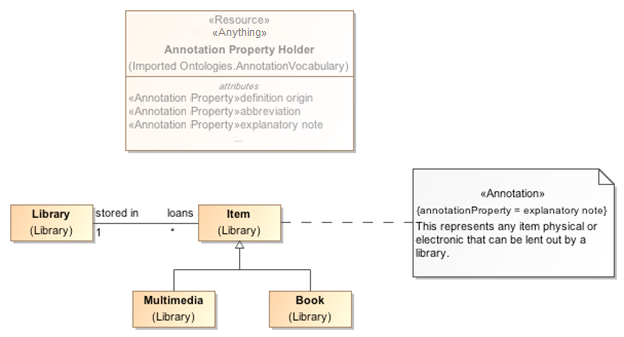The OWL language provides a way to comment on any subject that has a URI, using annotations. One can annotate classes, properties, and ontologies. In addition to providing a way to comment on a subject, the OWL language provides an open-ended way to define annotation properties. An annotation property defines a type of annotation with a relatively precise meaning.
Every annotation is a value for an annotation property. An annotation describes some subject URI using an annotation property URI and a (usually textual) value, forming what is called a triple. For example, a well-known vocabulary called Dublin Core defines an annotation property that has the URI http://purl.org/dc/terms/description. That annotation property is what the Concept Modeler uses by default to document a class called Person. It forms the triple http://example.com/ontology/Person http://purl.org/dc/terms/description “A human being”.
The Concept Modeler allows the user to define any number of annotation types. The user does this by declaring that a property is an annotation property using the «Annotation Property» stereotype on a UML property. Alternatively, a user can import annotation properties from existing OWL ontologies. When the Concept Modeler imports annotation properties, it automatically applies the «Annotation Property» stereotype.
Any UML comment can be exported as an OWL annotation. By default, the concept modeler converts UML element documentation, notes, and comments into the Dublin Core annotation property http://purl.org/dc/terms/description. When the user would like to use some other annotation property, he or she can specify which one as a tagged value in a UML comment stereotyped as an «Annotation». Applying this stereotype allows one to use any annotation property to provide more precise meaning for the information the comment contains and to properly export the comment into OWL.
For example, the following diagram illustrates a UML comment stereotyped with «Annotation» to document the concept Item. It uses a specific kind of annotation property, called explanatory note, to provide context for that documentation. That annotation property definition is shown as the third attribute stereotyped as an «Annotation Property» in the pink property holder. Its usage as a tagged value is shown as “{annotationProperty = explanatory note}” in the UML Comment stereotyped as an «Annotation». Please see the normal MagicDraw documentation for how to create a tagged value for a stereotype in the Specification window.
A comment stereotyped with «Annotation» to provide a correct meaning of an item.
You may have an imported model that contains annotation properties and documentation. A UML Comment can have more than one «Annotation» and each of these «Annotation»s can also have their own annotation property tagged value.
Related page
